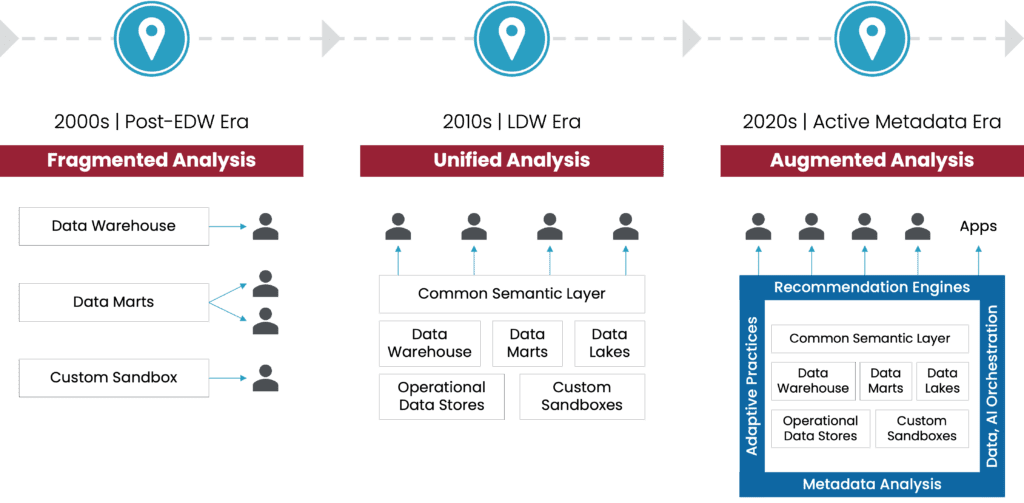Organizations across industries are reliant on data in the era of digital transformation. As data volumes continue to skyrocket, traditional centralized approaches to data integration struggle to keep pace. Enter data mesh – a decentralized and domain-oriented paradigm that is gaining popularity as a viable solution. Here, we will explore the concept of data mesh, its industry popularity, best practices, advantages, and disadvantages to draw a meaningful conclusion.
The Evolution of Data Architecture
Best practices for data analytics architecture have seen several eras as digital transformation initiatives brought attention to the need for modernizing data strategy and leveraging data analytics opportunities.

Industry Popularity
Data mesh has been steadily gaining popularity across industries including finance, healthcare, retail, and technology. Organizations strive to become more data-driven and agile. In doing so, they are recognizing the limitations of centralized data integration approaches. The data mesh philosophy emphasizes a domain-oriented approach, allowing cross-functional teams to take ownership of their data and enable faster, more autonomous decision-making. This decentralized model resonates well with organizations seeking to unlock the potential for their data assets.
4 Best Practices of Data Mesh
Implementing data mesh requires careful consideration of several key practices:
- Domain-Oriented Approach: Data mesh encourages organizations to organize their data around specific domains, where teams have ownership and expertise. Each domain operates as a self-contained unit responsible for its data products, data quality, and governance.
- Self-Serve Data Infrastructure as a Platform: Data infrastructure is treated as a product offering within the organization. It provides teams with the necessary tools, frameworks, and platforms to manage their data products independently. This empowers teams to make data-driven decisions efficiently.
- Federated Data Infrastructure: A federated data infrastructure provides the technical foundation for data mesh. It breaks down monolithic data platforms into smaller, more manageable components that can be independently operated and scaled. Technologies like data lakes, microservices, and event-driven architectures play a crucial role in supporting this decentralized approach.
- Data Product Thinking: Data mesh treats data as a product. This means defining clear product ownership, establishing product teams, and applying product management principles to data assets. Each data product should have a well-defined purpose, documentation, and metrics to measure its success.
Data Mesh Advantages
Data mesh offers several advantages over traditional data integration approaches:
- Scalability and Agility: By distributing data ownership to domain teams, data mesh enables organizations to scale their data capabilities more effectively. It reduces bottlenecks, improves agility, and promotes faster decision-making by empowering teams to make data-driven choices independently.
- Improved Data Quality and Governance: Data mesh encourages domain teams to take ownership of their data, leading to improved data quality. With clearer accountability and responsibility, teams can implement robust data governance practices and ensure compliance with regulatory requirements.
- Data Democratization: Data mesh breaks down the centralized gatekeeping of data, making it more accessible across the organization. This democratization promotes collaboration, knowledge sharing, and innovation, as teams can leverage data from different domains without heavy reliance on a central team.
- Efficient Collaboration and Knowledge Sharing: Data mesh encourages collaboration among domain teams and facilitates knowledge sharing. By treating data as a product, teams can learn from each other’s successes and failures, driving continuous improvement and innovation.
Common Challenges
While data mesh presents numerous advantages, it is important to consider potential challenges:
- Organizational Change: Implementing data mesh requires a significant cultural shift. It demands a rethinking of organizational structures, roles, and responsibilities. Overcoming resistance to change and ensuring effective communication and collaboration can be complex and time-consuming (but it’s worth it!).
- Increased Complexity: The decentralized nature of data mesh can introduce additional complexity in terms of data pipelines, integration points, and interoperability. Managing these complexities and ensuring data consistency across domains can be a daunting task (but the risk is worth the reward!).
Data mesh represents a paradigm shift in data integration, empowering organizations to navigate the challenges of the data-driven era. By decentralizing data ownership, fostering domain-oriented teams, and leveraging a federated data infrastructure, organizations can unlock the full potential of their data assets. While the adoption of data mesh may present certain challenges, the benefits of scalability, agility, improved data quality, and democratization of data outweigh the drawbacks. As more organizations embrace this transformative approach, data mesh is poised to revolutionize the way data integration is approached and executed in the future.
 Raj Suthan, Data Engineering Delivery Leader
Raj Suthan, Data Engineering Delivery Leader
